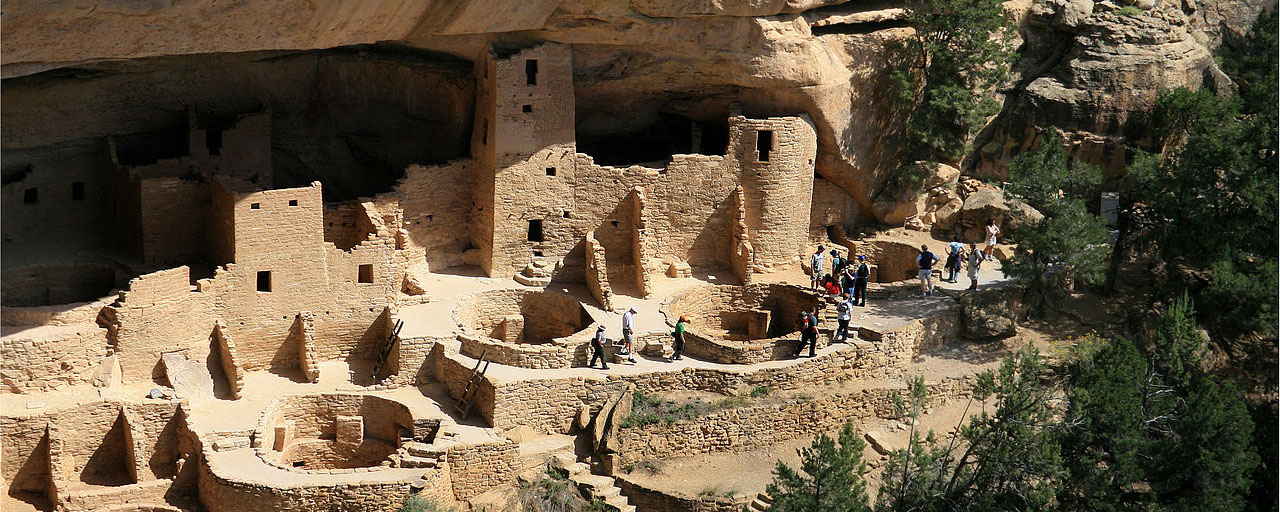1.2 Native American Societies Before European Contact
3 min read•june 18, 2024
Will Pulgarin
Jillian Holbrook
AP US History 🇺🇸
454 resourcesSee Units

Native peoples in the Southwest began constructing these highly defensible cliff dwellings in 1190 CE and continued expanding and refurbishing them until 1260 CE before abandoning them around 1300 CE. Andreas F. Borchert, Mesa Verde National Park Cliff Palace. Wikimedia. Creative Commons Attribution-Share Alike 3.0 Germany.
The marker of 1491 serves as a division between the Native American world and the world that came after European exploration, colonization, and invasion. In 1491, both North and South America were inhabited by flourishing and highly complex civilizations. In particular, North America was home to hundreds of tribes, cities, and societies. First Nation Peoples in North America are often grouped by similarities in their adaptations to the environments (desert vs arctic vs woodland societies).
Indigenous societies in North America before Europeans were vastly more complex than College Board requires for the exam, which focuses on the major tribes and societies within seven identified geographical areas and some basic components of their lifestyles. The intricacies missing from this curriculum are political, social, and cultural:
- What were the languages spoken?
- Where were the regional trade centers?
- How were conflicts resolved among different societies, and what were those conflicts?
While some of these details are lost to history due to the events that unfold on this continent after contact with Europeans, there are many, many more histories that are still preserved by indigenous people and communities today, even if they are not covered in the APUSH curriculum.
Permanent Settlements
The spread of maize cultivation from present-day Mexico northward into the present-day American Southwest and beyond supported economic development, settlement, advanced irrigation, and social diversification among indigenous societies. Through farming corn, beans, maize, and squash, tribes like the Apache, Navajo, and Pueblo built permanent settlements into the ledges of Mesa Verde.
Along the Northwest coast and in California, tribes developed communities along the ocean to hunt whales and salmon, building wooden lodgings, totem poles, and canoes from surrounding forests. These tribes included the Tlingit, Chinook, Coos, and Chumash.
In the Northeast, the Mississippi River Valley, and along the Atlantic seaboard, some indigenous societies developed mixed agricultural and hunter-gatherer economies that favored permanent villages.
Nomadic Hunting and Gathering Tribes
In contrast to the fixed societies of the Southwest, Natives in the Great Plains and surrounding grasslands retained mobile, nomadic lifestyles. Based on the aridity, or dryness, of the conditions, the Great Plains was more suitable for hunting and gathering, with food sources consisting of rabbits, snakes, birds, nuts, and insects. The Shoshone lived in cone-shaped huts built with wooden poles, covered with dried grasses and brush that could be packed and transported as the tribe moved.
The major groups and regions of First Nations Peoples to know for AP US History are:
Geographical Area | Arctic and Subarctic | Northwest Coast and California | Plateau | Great Basin | Southwest | Northeast (Eastern Woodlands) | Southeast | Great Plains |
Major Tribes | Eskimo and Cree | Tlingit, Chinook, Coos, & Chumash | Nez Perce | Shoshone | Apache, Navajo, and Pueblo | Iroquois, Mohawk | Cherokee, Seminole | Sioux, Cheyenne |
Housing | Igloos | Wooden houses; often sheltering several related families | Bison-high teepees; rounded homes of wood | Cone-shaped huts built with wooden poles, covered with dried grasses and brush. | Built homes on the ledges of Mesa Verde | Mound builders for burial | Reed and bark huts. | Teepees |
Food Supply | Hunting and fishing. | Whales and other sea mammals; salmon | Salmon (fish) | Rabbits, snakes, birds, nuts, and insects | Corn, beans, maize, and squash | Deer; corn, beans, squash, tobacco | Tobacco, squash, melons, cabbage, peas, and corn | Bison; wild edible plants and roots |
Clothing & Tools | Waterproof clothing and blankets; Tools made from bone and teeth | Animal skin clothing; spoons, masks, canoes, and totem polls | Deerskin clothing and robes of rabbit skin; Bows and arrows, spears, knives | Women wore strips of bark, sandals, and fur; baskets | Not stated | Clothing not stated; used forests to make tools, homes, fuel, and food | Clothing not stated; bows and arrows, blow guns, and traps | Bison fur; dogs were used to carry supplies. |
Present-Day | Canada and Greenland | Canada, California, Washington, and Oregon | Oregon, California, Idaho, and Canada | Nevada, California, Arizona, Utah, Idaho, Oregon | Mexico, Arizona, New Mexico, Utah, and Colorado | Stretched from New England to the Gulf of Mexico | Texas to West Virginia, down to Florida | Mississippi River to the Rocky Mountains, from Canada to Texas |
Browse Study Guides By Unit
🌽Unit 1 – Interactions North America, 1491-1607
🦃Unit 2 – Colonial Society, 1607-1754
🔫Unit 3 – Conflict & American Independence, 1754-1800
🐎Unit 4 – American Expansion, 1800-1848
💣Unit 5 – Civil War & Reconstruction, 1848-1877
🚂Unit 6 – Industrialization & the Gilded Age, 1865-1898
🌎Unit 7 – Conflict in the Early 20th Century, 1890-1945
🥶Unit 8 – The Postwar Period & Cold War, 1945-1980
📲Unit 9 – Entering Into the 21st Century, 1980-Present
📚Study Tools
🤔Exam Skills
👉🏼Subject Guides
📚AMSCO Notes

Fiveable
Resources
© 2025 Fiveable Inc. All rights reserved.